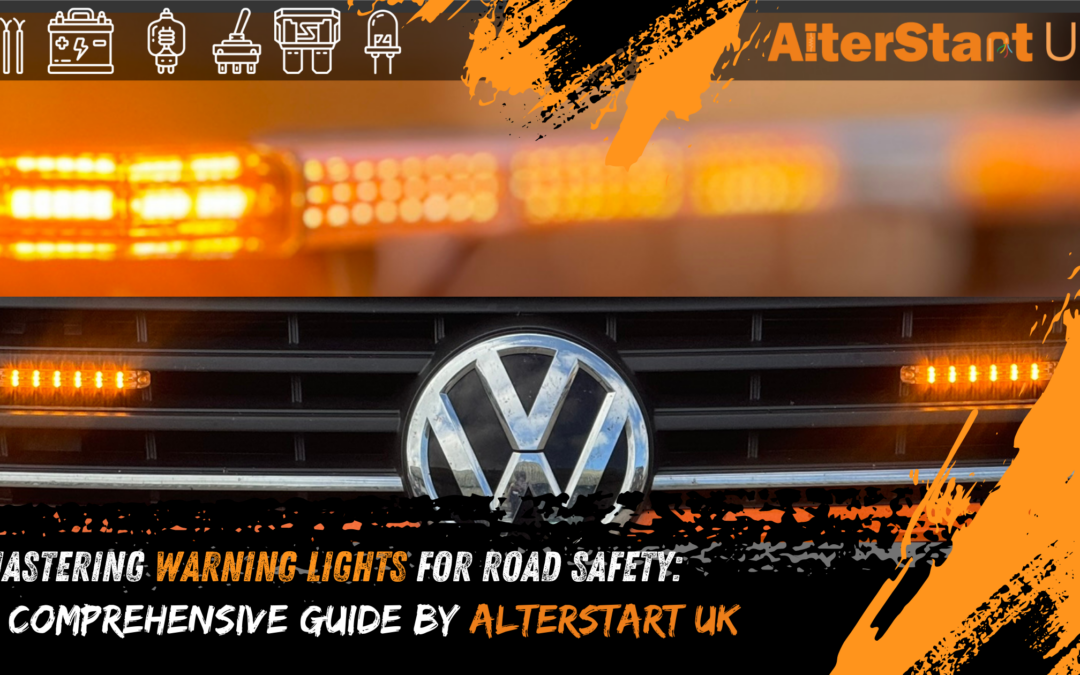Mastering Warning Lights for Road Safety: A Comprehensive Guide by Alterstart UK
Introduction
Warning lights are crucial for ensuring road safety, especially in the UK where specific regulations govern their use. These lights alert road users to potential hazards, such as stationary vehicles, ongoing roadwork, or wide loads. This guide provides an in-depth overview of warning lights, including their types, uses, regulatory requirements, and installation guidelines, to enhance safety and compliance.
Importance of Warning Lights
Warning lights play a vital role in:
- Enhancing visibility in low-light conditions
- Indicating the presence of hazards or unusual road conditions
- Communicating the need for caution to other road users
Applications of Warning Lights
- Road Maintenance and Construction Warning lights are essential for indicating roadworks, maintenance activities, or any obstructions on the road. They ensure that workers are visible and that drivers are aware of the need to slow down or navigate around the area.
- Towing and Transport Vehicles involved in towing or transporting wide loads must use warning lights to alert other drivers. This is particularly important for oversized loads that may require special navigation or pose risks.
- Emergency Situations Emergency vehicles, including police cars, ambulances, and fire engines, use warning lights to signal urgency and command the right of way. Similarly, these lights are crucial during roadside inspections, accidents, or breakdowns.
UK Regulations for Warning Lights
Understanding and complying with UK regulations is vital for the proper use of warning lights. The primary regulations include:
- REG 65 Compliance: Warning lights must emit an orange-yellow flashing light, ensuring high visibility.
- Type Approval: Lights should be type-approved according to ECE 65 or an equivalent standard.
- ECE R10 Classification: This classification prevents electronic interference with the vehicle’s systems, ensuring safe operation.
Detailed Installation Requirements
- Positioning: Lights must be positioned to offer 360° visibility at a height of at least 1.20m from the ground, ensuring they are seen from all angles.
- Visibility: The lights should emit light to the ground, ensuring consistent visibility.
- Indicator Lamp: An indicator lamp visible from the driver’s seat is necessary to confirm the lights are operational.
- Synchronization: If multiple warning lights are used, they must switch on and off simultaneously to provide a clear and unified signal.
Types and Classifications of Warning Lights
Class 1 Warning Lights These are basic warning lights that provide a single level of brightness. They are typically used in situations where consistent visibility is required regardless of the time of day.
Class 2 Warning Lights These lights offer adjustable brightness, making them suitable for both day and night use. They reduce glare during nighttime operations, ensuring safety without compromising visibility.
Battery and Control Systems
To ensure the effectiveness and reliability of warning lights, they must be properly connected to the vehicle’s battery with a monitor to prevent drainage. Advanced control systems can manage multiple lights, providing synchronized operation and enhancing overall safety. Learn more about making sure your vehicles electrical system is ready for additional lighting in our article here.
Comprehensive Checklist for Ordering Warning Lights
When ordering warning lights, consider the following:
- Select the Right Light: Choose a warning light that meets your specific needs and complies with regulatory standards.
- Mount Selection: Ensure you have the appropriate mounts for secure and effective installation.
- Cabling and Controls: Choose the right cabling and control systems to ensure the lights function correctly and efficiently.
Enhancing Visibility with Additional Tools
Roof Signs and X2-Signs For additional visibility, especially on high-risk roads, consider using roof signs or X2-signs. These signs, when properly installed, can greatly enhance the visibility of your vehicle and the warnings it provides.
Consultation and Professional Installation
To ensure compliance and effectiveness, consult with professionals when selecting and installing warning lights. This ensures that all components are correctly ordered and installed, and that the system functions as intended.
Conclusion
Proper use and installation of warning lights are paramount for road safety. Adhering to UK regulations and consulting with experts can help ensure that your warning lights are both effective and compliant. Stay informed and equipped to enhance road safety for everyone.
